
Tree of Merit
Silk floss tree (Ceiba speciosa)
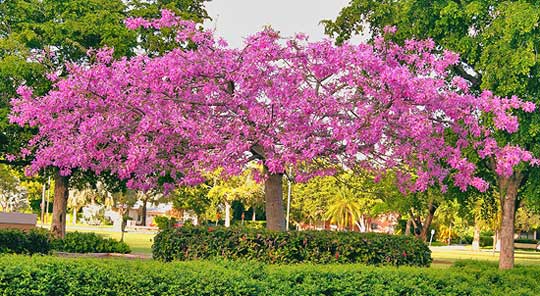
Story and photos by Jeff Shimonski, Director of Horticulture, Jungle Island, Miami, Florida
Reprinted from:
City Trees: Journal of the Society of Municipal Arborists
www.urban-forestry.com
March 2008
The silk floss tree, Ceiba speciosa, is a tropical tree native to Brazil and northern Argentina. In South America, where it is often used as a street tree, it is sometimes known by common names corisia morada or palo borracho. Well known for its spiny green trunk, it is a stunning tree when in bloom. From a tropical point of view, it is also a hardy tree that can tolerate drought and light frost once established. The tree appears to be fairly salt tolerant, and it grows well in coastal areas.
This Ceiba species was until recently known as Chorisia speciosa. There also may be some confusion regarding the species, as the color of the flowers on individual trees can range from light pink to dark purple. It is always interesting to grow silk floss trees from seed, as there is much variation in flower color and in the amount of spines on the trunk.
In the winter or the dry season, the silk floss is deciduous. A profusion of blooms that may last for over a month is usually seen in the fall; however, I believe irrigation conditions and local rainfall can affect flowering. I have seen individual trees bloom in the spring and the fall. The characteristic blooming at the beginning or near the end of leaf fall gives pollinators better access to the individual flowers, which can increase fruit set. From an aesthetic point of view, since the flowers are not mixed with foliage, there’s a brilliant show of color. The fruit is smooth and green, about the size of an avocado. It will eventually split open, and seeds attached to long white hairs will blow away in the wind.
Ceiba and other closely related species like the baobab and the kapok, in the family that was formerly the Bombacaceae (now included in the Malvaceae), are easily grown from seed. I understand that they can be grown from cuttings, but I have never had any luck with this method of propagation. Large specimen trees relocate well, but the wood and branches are easily scarred and broken; trees should be picked up from the bottom.
Best grown in sandy, well-drained soil with a small amount of organic material, these trees can grow quite fast when water is abundant. They seem to grow in spurts and sometimes develop distinctive bottle-shaped trunks. Trees that I have grown from seed have reached 60 feet (20 meters) in 15 years.
Jeff Shimonski, Director of Horticulture, Jungle Island, Miami, Florida
NOTE: Trees of Merit are not suitable for every climate and site condition. Variations in regional performance will apply. If you are using a Tree of Merit in your municipality, please share your experience with it on the SMA Listserve


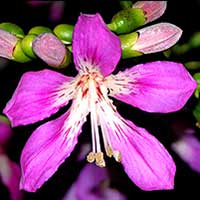
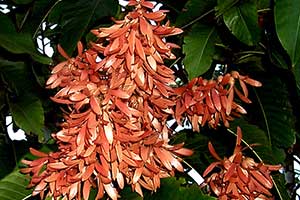 About Tropical Trees & Arboriculture
About Tropical Trees & Arboriculture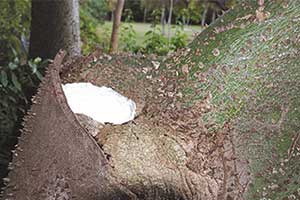 An Experiment in Arboriculture and Mosquito Control
An Experiment in Arboriculture and Mosquito Control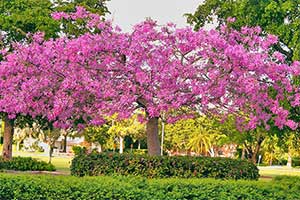 Ceiba Speciosa
Ceiba Speciosa Why Trees Blow Over
Why Trees Blow Over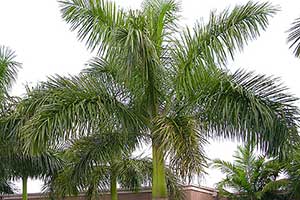 Royal Palm Bugs
Royal Palm Bugs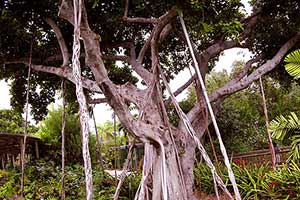 Ficus Species & Hurricane Horticulture
Ficus Species & Hurricane Horticulture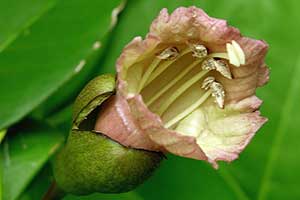 Pollination and the Natural History of the Calabash Tree
Pollination and the Natural History of the Calabash Tree Pollinating Sausage Trees
Pollinating Sausage Trees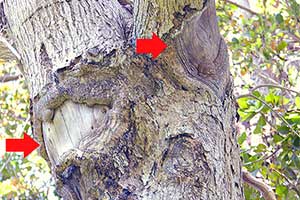 Some Observations on Relocating Tropical Trees
Some Observations on Relocating Tropical Trees